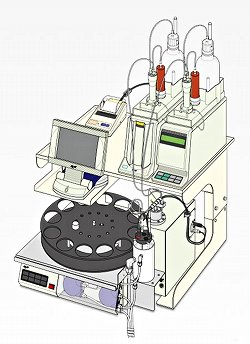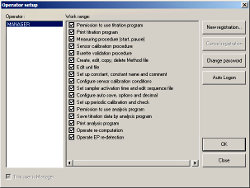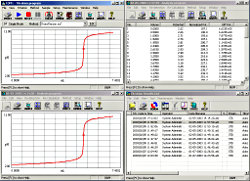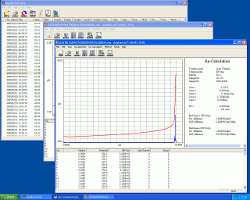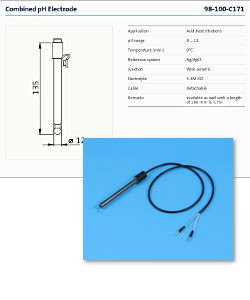Reagent information directly stored in the burette unit
Important reagent information such as type of reagent, titer, last titer determination etc. is stored in an IC chip directly in the burette unit. The titrator automatically detects whether the reagent used is suitable for the method selected, errors due to wrong reagent data are a thing of the past.
Automatic monitoring, alert and check functions
The reliability of titration results depends on a number of factors. The AT-710S offers a multitude of helpful functions and automatic alerts which help to avoid the most frequent sources of error such as non accurate sensor calibrations, expired reagents, non accurate burettes or measuring errors due to temperature fluctuations.
Advanced tools for method development
The AT-710S and AT-710M titrators offer all the functions required for smooth method development even for applications which do not yield neat titration curves. In some cases several sensing techniques are worth to be considered in order to reliably detect the correct endpoint. For this reason the AT-710S and AT-710M offer in addition to a full set of reevaluation functions an unique feature: They can perform titrations collecting the signals of two types of detectors simultaneously!
Overheating protection built-in
Temperature is monitored during titration and titer addition is interrupted when the temperature exceeds the specified upper limit. This ensures safe measurements even when titrating concentrated acids with concentrated bases during which the temperature tends to be raised.

Substantial accuracy and reliability enhancement
High resolution burettes, small dead volumes and automatic compensation of the influence of ambient temperature fluctuations: The AT-710 titrators come with all the prerequisites that ensure highly accurate results:
The burette drives have a resolution of 20’000 steps.
No more classical turning valve connected to the burette: The AT-710 titrators come with a newly developed valve mounted directly on top of the burette. Advantage: Less connecting tubes, which means less cross contamination when replacing reagents and less room for air bubble formation.
Fluctuations of the ambient temperature can cause measuring errors. With an optional temperature sensor the AT-710 titrators monitor the temperature of the titration reagent and correct errors due to volume expansion automatically.

Electrode data stored in the cable
The optional smart electrode cable with IC chip stores calibration results, replacement date etc. of an electrode. Time consuming recalibration can be avoided when multiple electrodes are used.
Smooth data entry and control
Transmitting sample weights directly from a balance, inputting sample names with a barcode reader, entering sample codes with a numeric keypad: The AT-710 titrators offer all the interfaces and features required for a seamless integration into your workflow.
- Amino acids in Sake
- pH value and titrable acidity
- CO2 content
- Chloride (NaCl)
- Free and total sulfurous acid
- Volatile acids
- Citric acid
- Phosphoric acid
- Calcium
- Ascorbic acid
- Kjehldahl nitrogen
- Fluoride
- Total iodine
- Nitrite
- Ash alkalinity
- Free fatty acids
- Iodine value
- Saponification value
- Formol number
- Reducing sugars
- Oxalic acid
- Free fatty acids
- Peroxide value
- Peroxide value of oleic acid
- POV of animal fat
- Saccharin
- Cyclamate
- Methoxy and ethoxy groups
Standards
ASTMD558
E203
D695.33
AOAC695.33
- Acid number of biodiesel
Acid number of resin
- Peroxide number of kerosene
- Total acid number (TAN)
- Base number
- Total base number (TBN)
- Chloride
- Bromine number
- Bromine index
- H2S
- Mercaptan
- Saponification number
- Hydoxyl number
- Hydoxyl value of polyether polyol
- Organic chlorine content
- Isocyanate
- Monomer residues in PE
- Carboxyl group in PET
- Sodium Hydroxide
- Purity of acrylic acid
- Nitrogenous bases
- Sodium Polyacrylate
- Acid consumption of detergent
- Purity of Benzoic Acid
- Sulfadimethoxine in dye
- Chloride in dyestuff
- Amino group in dyestuff
Standards
ASTMD94
D664
D974
D1159
D2420
D2710
D2896
D3227
D4739
D4929
D5776
D6470
E1899
DIN51559
DIN ISO3771
DIN EN12634
IP177
GOST29255
ISO3012
3839
6619
14900
JISK0070
K2501
K4101
K8073
K8150
K1557-1
JPI5S-46-96
UOP163
209
212
304
588
- Various active ingredients
- Determination of iodine
- Benzethonium chloride
- Benzalkonium chloride in bactericide
- Ca and Mg in dialysis solution
- Chloride in pharmaceutical products
- Al and Mg
- Sodium hydrogen carbonate
- Purity of salicylic acid
- Sodium sulfate in cosmetics
- Anionic surfactants
- Cationic surfactants
- Al and Mg
- Urea
- Total hardness (Ca and Mg)
- Alkalinity
Standards
EN ISO9963
DIN38406-3
38405-1
EPA130.2
310.1
- Sulphuric acid
- Hydrochloric acid
- Sodium Hydroxide
- Ammonium Hydroxide
- Boric acid in electrolyte
- Ferric iron in hydrochloric acid
- Trace chlorine in cements
- Aluminium oxides in cements
- Cobalt in cemented carbide
Standards
CIS032B
ISO6353-3
JISK8863
- Cu in metal baths
- Ni in metal baths
- Boric acid in nickel baths
- Tetrafluoroboric acid in Ni baths
- Surfactants in plating baths
- Cadmium in plating baths
- Cyanide in plating baths
- Tin in plating baths
- Chloride in plating baths
- Hydroxide and carbonate in plating baths
- Cr(IV) and Cr(III) in chromium baths
- H2SO4 in etching solution
- Chromic acid in chrome bath
- Ferrous salt in etching solution
- Ferric salt in etching solution
- Nickel Sulfate in electrolytic colorant
- Amine in electrodeposition paint
- Acid number in insulating oils
- Boric acid concentration
- Total acid number in insulating oils
Standards
ASTMD974
BS148
JISC2101
K8137
K8142
JPI-5S-57-99760













